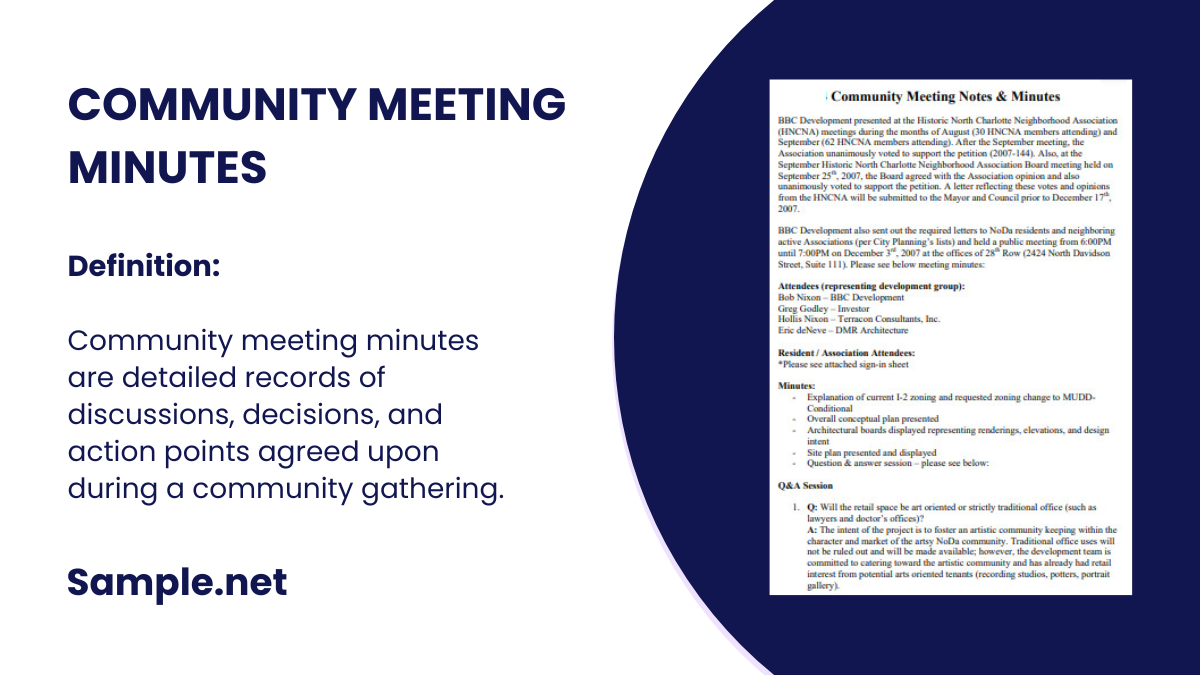Community meeting minutes are detailed records of discussions, decisions, and action points agreed upon during a community gathering. They ensure that all participants have an accurate summary of the…
continue reading
10+ Sample Training Meeting Minutes
-
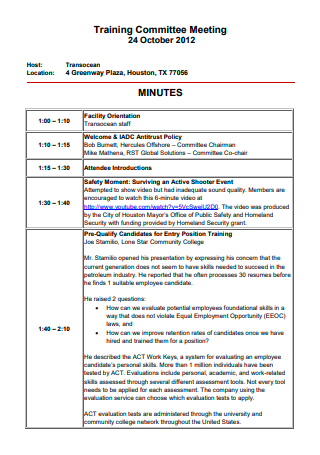
Training Committee Meeting Minutes
download now -
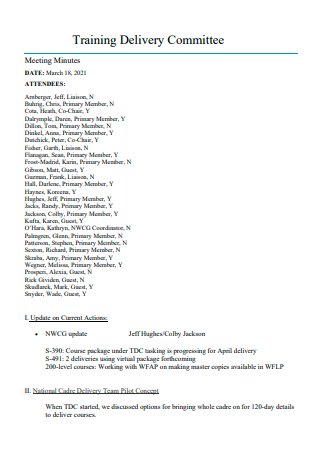
Training Delivery Committee Meeting Minutes
download now -
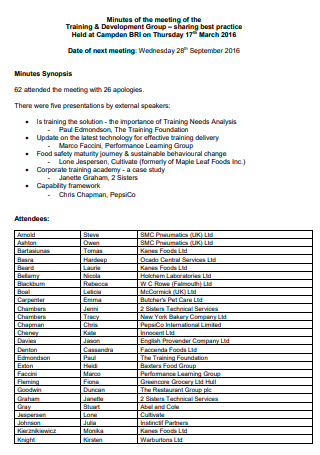
Training and Development Group Meeting Minutes
download now -
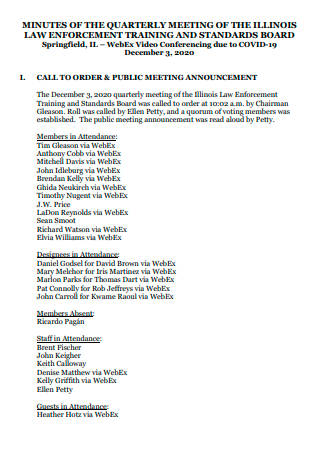
Law Enforcement Training Meeting Minutes
download now -
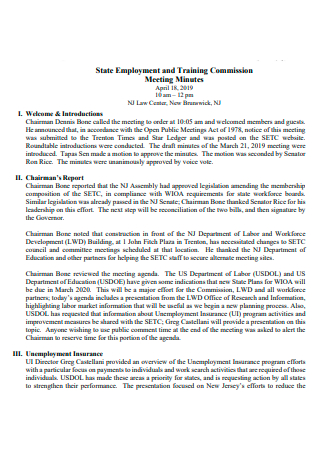
Employment and Training Meeting Minutes
download now -

Training Meeting Minutes Example
download now -
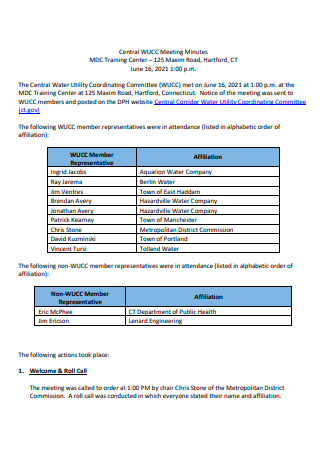
Training Center Meeting Minutes
download now -
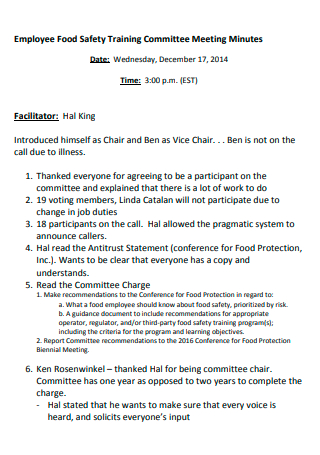
Employee Food Safety Training Committee Meeting Minutes
download now -
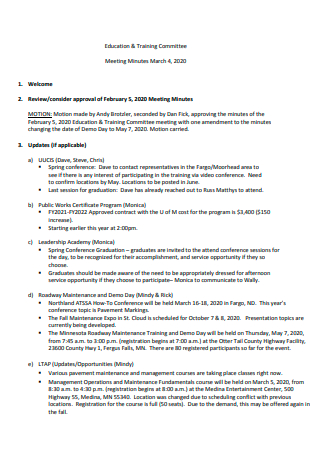
Education and Training Committee Meeting Minutes
download now -
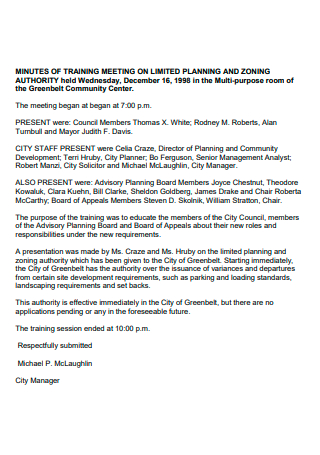
Training Meeting Minutes in PDF
download now -
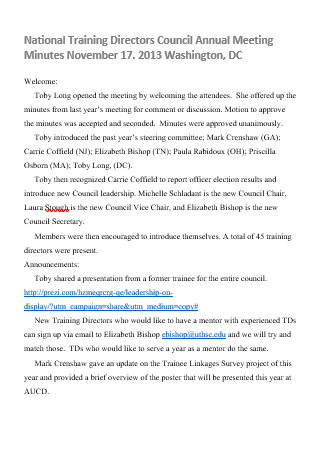
National Training Directors Council Meeting Minutes
download now
What Is Training Meeting Minutes?
There are no limits to the number of people who can attend meetings, and they can be utilized for any number of objectives, from exchanging information to achieving consensus. A well-known and often used method of bringing people together is through training sessions. These gatherings allow participants to express their thoughts, hear from a public speaker or learn about a proposed plan, participate in shared learning about a topic, or work together to find answers to problems. A script or an agenda are not required for training meetings, and participants are encouraged to bring their own ideas. Depending on the specific requirements of the project, the organization, or the group of stakeholders, they can be adjusted to meet those criteria. The opportunity for all stakeholders, not just those associated with the agency, to listen to and converse with one another is the most major benefit of group meetings.
Various more meeting minutes templates are available for download on our website, which you can use as often as you need. The names of them are as follows: Neighborhood meeting, police meeting, meeting flyer, stakeholder meeting, quarterly meeting, upcoming meetings, small group meeting, community board meeting, morning meeting, Planning Reports strategic planning meeting, and other similar Team Meeting Minutes templates are all available for you to download and use. As well as templates, this post contains critical information that you should be aware of in order to successfully complete your template. You should also see our administrative meeting minutes.
Elements of Training Meeting Minutes
If the meeting is not carefully prepared and well facilitated, people who are believed to have the most influence within the organization, as well as those who are the most articulate and domineering in their linguistic style, can easily take control of the conversation. If the meeting is not well planned and well-conducted, the voices of the other participants will be drowned out. Even if a large number of people attend, meetings will only reach a small percentage of the population that is in desperate need of information and whose participation may be extremely beneficial in the development of solutions to the issues being discussed. In certain cases, participants may not come from a varied enough range of backgrounds to effectively represent the entire group, resulting in an inaccurate portrayal of what the general public genuinely believes. Conflicts may be worsened rather than being explored and potentially resolved if they are not properly planned and coordinated. It is possible that citizens will be unwilling to collaborate on a project in the future. If the purpose of a meeting is not clearly specified and well-publicized, the attendance will be poor. Take into consideration the fact that time is valuable to everyone, particularly in small towns and villages. Educating the public on what to anticipate from the meeting and what they will be expected to do would be good in this situation.
Steps in Writing Training Meeting Minutes
Running or chairing meetings requires more than simply getting everything done on time; it also requires a high level of interpersonal skills. When you preside over a meeting, you take on the duty for the well-being of the group and its members as a whole. Due to this, it is necessary to pay special attention to both the “group dynamics” and various other process factors.
-
1. Preparing for the Meeting
Determine your clear goal, and the Effective Meeting Agenda will serve as a road map to guide you toward reaching that goal. When you plan with your group, it is a fantastic approach for developing new leaders and involving other people more fully in the activities of your group. Make an agenda with three or four people who are interested in the subject and work on it for no more than an hour. Make a list of the items on your To-Do List, as well as the amount of time you anticipate spending on each item. Make sure to include the information about anyone else who will be presenting a piece of the agenda as well, and make sure to send it out at least one week before the event. Before arriving, members of any group should be aware of the tasks they will be asked to complete. It is important to ensure that the agenda covers all of the necessary stops and does not include too many unnecessary detours if the agenda serves as a road map for you. Don’t keep what will be discussed a secret; instead, make sure that everyone is aware of what will be discussed. You should also see our financial meeting minutes.
-
2. Getting the Meeting Started
Members’ time is valuable, and taking advantage of it is one of the most severe turn-offs there is. For example, if you are forced to begin late because there are only three people present when you are supposed to begin, you should at the very least express regret for being late. To get into the habit of starting on time, start early and often, even if there are just three people in the room. Once the news gets out, people will either show up on time or fail to show up altogether. If people are routinely late or do not show up at all for meetings, you may want to consider modifying the time of your meetings or the pattern of your meetings. For guests, meeting venues should be both comfortable and easily accessible from their homes or places of work. A convenient location and a room that is the suitable size for the number of persons in your party are essential considerations. If at all feasible, arrive early to set up and seek a venue where you can sit in a circle rather than in rows, such as an auditorium, to maximize your comfort. It may be necessary to arrange transportation or a volunteer “escort” service for elders or others who may find it difficult to travel to the meeting location on their own. Allow for informal interaction and socialization between participants before and after the meeting by scheduling time before and after the meeting. Because people joined your organization in the first place, they are far more likely to participate, and it is also where you will get volunteers. Remember that the “meeting after the meeting” is oftentimes the time when people grow more attached to the group—as well as the time when they acquire their finest ideas to present at the next meeting. You should also see our operations meeting minutes.
-
3. Taking Charge of the Meeting
The process of doing introductions comprises both seeking everyone else’s introductions and introducing yourself and your function. It is your obligation to introduce any special guest speakers who will be appearing at the meeting. Always remember how powerful icebreakers can be at bringing everyone’s spirits up! During the first few minutes of a meeting, participants engage in a short exercise that helps them get to know one another while also digging out some important information in a fun or engaging way. A “Scavenger Hunt,” for example, might be organized by your organization in which participants “scavenge” for information about one another’s characters. You should also see our marketing meeting minutes.
-
4. Taking Action Following the Meeting
Information on how the meeting went, what could have been improved, and so on and so forth will be sought after. At least once a month, you should make certain that everyone understands their obligations, arrange or confirm the date for the next meeting, and provide as many opportunities for employees to stay after the meeting in order to discuss their concerns (which is very important).
You now have the knowledge and skills necessary to properly plan and complete effective meetings in your organization. A good meeting that is properly planned, focused, and efficiently conducted can assist your organization in becoming a quality organization, but a meeting that is poorly managed or run will cause your organization plenty of difficulties.
FAQs
What are meeting minutes for?
Meeting minutes are notes taken during a meeting to record what happened! Unlike a meeting agenda, it records the committee’s decisions and requests. Despite the team’s best efforts, they are not a minute-by-minute record, but rather a compilation of key information.
What constitutes an excellent meeting place?
A meeting is good for exchanging ideas and information since it brings together a variety of viewpoints. Meetings that successfully bring together a varied mix of motivated participants to share information, find resources and volunteers and set goals and action plans
What should my meeting minutes exclude?
This additional information can help establish a rebuttable presumption that the behavior was reasonable, avoiding an IRS penalty. Because minutes are public records, it is vital to specify what should be withheld. Avoid direct quotations; even if the speaker isn’t identifiable, they can be.
Management has been responsible with running meetings on a regular basis, hence they must ensure that the meeting gets started and ends on schedule. They’ll be grateful that you recognize the importance of their time if you recognize this. Keep in mind that, for the sake of time management, no meeting should last longer than one hour during a business meeting. A staff meeting should last no more than 60 minutes, if at all possible. Additionally, management must ensure that meeting attendees are well-nourished and physically active throughout the event by providing nutritious food, beverages, and snacks throughout the event.
